This site is supported by our readers. We may earn a commission, at no cost to you, if you purchase through links.
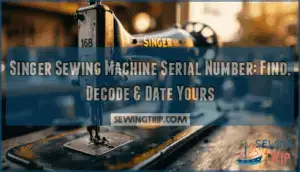 You just inherited your grandmother’s old Singer and found a jumble of numbers stamped on the metal. Those digits aren’t random factory markings. They’re a secret code that tells you exactly when your machine rolled off the assembly line, where it was made, and whether you’re possessing a common workhorse or a rare treasure.
You just inherited your grandmother’s old Singer and found a jumble of numbers stamped on the metal. Those digits aren’t random factory markings. They’re a secret code that tells you exactly when your machine rolled off the assembly line, where it was made, and whether you’re possessing a common workhorse or a rare treasure.
Every Singer sewing machine with a serial number carries its own fingerprint. Learning to read those numbers transforms a dusty antique into a documented piece of history. Once you crack the code, you’ll know if your machine is worth restoring or if it belongs in a museum.
Table Of Contents
Key Takeaways
- Singer serial numbers reveal exactly when and where your machine was made, with pre-1900 machines using only numbers while later models added letter prefixes indicating specific factories (like "K" for Kilbowie, Scotland).
- You’ll find your serial number stamped on the bed plate’s front right corner, the machine’s underside, throat plate, or front arm depending on the model and manufacturing era.
- Machines with rare serial ranges command premium prices—pre-1900 models (below serial 1 million) fetch $1,200+, while Featherweight 221s with AE-AG prefixes sell for $700-$1,000.
- Your serial number unlocks access to the correct manual, authentic replacement parts, and accurate dating through online databases like ISMACS that track over 53 billion Singer machines from 1850 to 1971.
Finding Your Singer Sewing Machine Serial Number
Your Singer serial number is the key to unlocking your machine’s story. It tells you when your machine was made and where it came from.
Your Singer serial number unlocks your machine’s story—revealing when and where it was made
Let’s find that number so you can start decoding your Singer’s history.
Common Serial Number Locations
Finding your SINGER machine’s serial number is like a treasure hunt through history. Start by checking these five spots:
- Bed Plate – Look at the front right corner where more than 70% of pre-1950 machines display their numbers.
- Front Arm – Check the face or arm section on industrial models like the 16 and 24 classes.
- Underside Markings – Tilt the base to find stamped digits on a raised metal pad (standard after 1950).
- Throat Plate – Peek beneath the slide plate near the bobbin case on older domestic models.
- Rear Arm – Inspect behind the balance wheel on industrial sewing machine parts.
Most numbers hide in plain sight once you know where to look!
Identifying Serial Numbers on Different Models
Each SINGER model tells its story through where it hides its serial number. Featherweight models like the 221 and 222 stamp their AD through EJ prefixes right on the base. Model 15-class machines show K, M, or J letters depending on whether your machine sailed from Scotland, Italy, or Japan.
Industrial model numbers on the 16 and 24 classes appear on the front arm instead of the bed. Early treadle machines display numeric-only serials before the 1900 prefix switch. Limited edition serials sometimes overlap across factories, creating serial number anomalies that puzzle collectors!
To accurately identify your machine, you’ll need to locate the serial number.
Tips for Locating Faded or Hidden Numbers
Sometimes the years etch away more than memories. Your SINGER sewing machine’s serial number might hide under decades of dust or oxidation.
Start with surface preparation: dampen a soft cloth with sewing machine oil to gently loosen grime without harming decals. Lighting techniques work wonders—angle an LED torch at 30° to cast shadows that reveal faint stampings. Check hidden locations like bottom trays on Featherweights or beneath the bed edge on 1950s models. Use safe tools like nylon brushes instead of steel wool.
Apply preservation practices by coating cleaned plates with a thin oil layer. These tricks reveal the history of SINGER machines and help you identify any sewing machine model. Determining the model can also be achieved by examining the machine’s overall lines.
Decoding Singer Sewing Machine Serial Numbers
Once you’ve found your serial number, the next step is cracking the code. Singer used different numbering systems over the years, and understanding what those digits and letters mean helps you pinpoint your machine’s age and origin.
Let’s break down how Singer serial numbers work and what they tell you.
Understanding Numeric and Letter Prefixes
Ever wonder why some Singer machines have just numbers while others start with letters? Singer’s serial system evolved like the company itself. Before 1900, SINGER used purely numeric serials that climbed into the millions. When production exploded at the turn of the century, letter prefixes entered the picture to track machines across factories worldwide.
Here’s what those prefixes reveal:
- Single letters (1900–1930s) – "K" meant Kilbowie Scotland while "A" could signal Anderson or Podolsk depending on the range
- Double letters (1930s onward) – "EA" or "JC" pinpointed both factory and batch as output soared past one million machines yearly
- Smart exclusions – No "O" or "Q" to avoid mix-ups with "0" and "9"
- Wartime shifts – Assignments sometimes lagged during 1939–1946 disruptions
- Global codes – Japan got "U" and Italy’s Monza used "M"
Understanding these prefix meanings helps you identify where your machine called home during the History of SINGER brand development!
Serial Number Structure and Meaning
Your machine’s serial structure works like a coded address. Pre-1900 SINGER sewing machines carried only numeric Register Numbers tracking global production across all factories.
After 1900, Factory Codes appeared as letter Prefixes showing where your machine rolled off the line—"K" for Kilbowie or a dash for Elizabethport. Number Length grew from six digits to eight as SINGER brand milestones passed twenty million units.
Model Identification merged class numbers with Factory Codes to create complete Sewing Machine Specifications like "15K80"—revealing both design and birthplace in one stamp!
Differences by Manufacturing Era
Throughout serial number evolution, each era tells its own story. Here’s what changed:
- Pre-1900 machines show pure numeric stamps on cast iron bedplates—your clue to hand-crank heritage and foundational SINGER brand milestones.
- 1900–1940s sewing machines added factory location codes like "K" for Kilbowie, marking global expansion during wartime production peaks.
- Mid-century models merged class numbers with sub-versions, tracking design change correlation as electric motors replaced hand-cranks.
- Modern SINGER sewing machine models use alphanumeric codes with barcodes, sacrificing romance for database dating precision!
Dating and Identifying Your Singer Machine
Now that you’ve found and decoded your serial number, it’s time to put that information to work. Your serial number is the key to unlocking your machine’s age and identity.
Let’s see how you can use it to figure out exactly what you have.
Using Serial Numbers to Determine Age
Your Singer serial number acts like a time capsule that reveals when your machine was born. Dating accuracy gets sharp if you understand how Singer assigned numbers in batches. Allocation dates sometimes came 6 to 24 months before actual production wrapped up.
Wartime delays between 1939 and 1945 stretched things even further. Factory variations and number anomalies pop up during busy years like the 1920s.
Online resources like ISMACS help you pin down your SINGER sewing machine’s age within a year or two.
Matching Serial Numbers to Model Types
Think of serial numbers as street locations that point you to specific SINGER sewing machine models. Batches of numbers were assigned to particular classes at specific factories.
Database discrepancies sometimes appear between serial records and actual model features. You’ll need to cross-check factory variants and branding differences for precise identification.
Online databases tracking over 53 billion numbers from 1850 to 1971 help match your domestic machine to its exact type. Model variations might share similar serial allocation ranges but differ in mechanical details between factories.
Singer Serial Numbers and Collector Value
Once you’ve dated your machine, you might wonder what it’s actually worth. The serial number plays a bigger role in value than you’d think.
Let’s look at what makes some vintage Singers more valuable than others.
Factors Influencing Antique Machine Value
Condition is king when you’re valuing an antique SINGER sewing machine. Original finishes can bump up prices by 40% compared to repainted models. Rust-free machines retain 90% of their value. Working mechanics add another 25-35% to what you’ll get.
Provenance impact matters too—documented history can raise auction prices by 50%. Market demand for vintage crafts has pushed prices up 17% yearly since 2022. Model rarity plays a huge role.
Domestic machines usually sell between $50-$500 depending on condition premium and restoration quality.
How Serial Numbers Affect Rarity and Worth
Your machine’s serial number isn’t just a factory stamp—it’s a treasure map to rarity and value. Early sequences (pre-1900) make up less than 1% of SINGER’s 53 billion documented units, instantly boosting collector appeal. Here’s how serial numbers impact worth:
- Commemorative editions sell for 2-3× more than standard runs due to limited batches
- Provenance verification through ISMACS databases increases sale prices by 60%
- Geographic variations from smaller plants like Clydebank show higher scarcity
- Numbering errors from pre-WWII production create unique desirability
- Missing serial plates drop value by 40% without traceable history
Verified serial authentication certificates justify premium pricing in today’s sewing machine market.
Examples of High-Value Serial Number Ranges
Now that you know how serial ranges connect to value, let’s look at specific numbers that make collectors pay attention. Pre-1900 values below serial 1 million often top $1,200 at auction. The Featherweight 221 sewing machine with AE-AG prefixes (1937–1941) brings $700–$1,000. Centennial Editions marked JA–JB from SINGER’s 100th anniversary hit $1,500 in mint shape. Industrial models like F-series machines fetch $700–$1,100. Transitional runs with AB–AC prefixes from early electric experiments can reach $2,000. Your brand’s history makes these sewing machine models worth hunting down.
| Serial Range | Estimated Value |
|---|---|
| Below 1,000,000 (1850–1871) | $1,200+ |
| AE–AG prefix Featherweight (1937–1941) | $700–$1,000 |
| JA–JB Centennial (1950–1951) | $1,200–$1,500 |
| F-series Industrial (1910–1915) | $700–$1,100 |
| AB–AC Electric Prototypes (1930–1931) | $2,000+ |
Accessing Singer Machine Manuals and Support
Once you’ve tracked down your machine’s serial number and figured out its age, you’ll want to grab the right manual and parts. Your serial number is the key to finding exactly what you need.
Here’s how to put that number to work for you.
Finding Manuals by Serial and Model Number
You’ve got your serial number and model ready. Now you can track down your manual. Singer’s digital archives house downloadable PDFs for most sewing machine models from the 1980s forward. Enter both serial and model details for manual accuracy since serial variants exist.
Community resources like ISMACS and Manualslib fill gaps when official support comes up short. These tools help with machine maintenance and model identification fast.
Using Serial Numbers to Order Parts and Accessories
Once you’ve nailed down your manual, your serial number becomes your key to ordering the right SINGER parts and accessories. Here’s how to use it:
- Authentic Part Sourcing – Serial-matched listings prevent counterfeits and guarantee fit reliability over 98% of the time.
- Digital Catalog Integration – Platforms like SingerOnline and LRCrafts link your serial number directly to compatible parts, cutting search time in half.
- Prefix Part Series – Letter prefixes reveal your machine’s factory origin, which determines the correct part family for your sewing machine.
- Accessory Compatibility – Buttonholers and binders cross-reference to your serial for perfect pairing with your model’s hook type.
- Counterfeit Prevention – Original Simanco part numbers traced from your serial stop substitutions before they happen.
Enter both your serial and model at support.singer.com for warranty validation and authentic parts.
Frequently Asked Questions (FAQs)
How do I look up a Singer sewing machine serial number?
You’ll find your serial number stamped on a metal plate attached to your machine. Check the front panel near the power switch first. Then look under the base or behind the faceplate.
SINGER machines made before 1900 used numbers only, while later models added letter prefixes.
How do I know if my Singer sewing machine is worth money?
Imagine this: you uncover a dusty treadle machine in grandma’s attic and wonder if you’ve struck gold. Your machine’s worth hinges on age, condition, model rarity, historical significance, and market demand.
Machines over 100 years old in excellent condition fetch top dollar. Common SINGER models usually sell for $50 to $500, while rare specimens can command four times that range with solid provenance records.
What is the most sought after Singer sewing machine?
Collectors prize the Featherweight 221 most of all. This portable black beauty from the 1930s-1960s combines rarity and charm.
Machines in mint condition with original cases can fetch top dollar. The historical significance and reliable stitching make it Isaac Merritt Singer’s most beloved legacy.
How much is a Singer 15 88 worth?
Don’t assume it’s worthless because it’s common. The Model 15-88 Value generally ranges from $50 to $200 depending on Condition Impact and completeness.
Sewing Machine Dealers note working machines in original cabinets command higher prices despite Market Trends favoring rarer SINGER models.
Where can I find my Singer sewing machines serial number?
Your serial number lives in one of a few key spots. Check the front faceplate near the throat plate. Look under the machine base or on the right side panel.
Some models hide it inside small compartments near threading guides.
How do I find the year my Singer machine was made?
Once you locate your serial number, use SINGER production records to pinpoint the exact year. Dating methods include serial lookup tools and model timelines that match your number to manufacturing dates. Sewing machine features and design also help verify age.
How do I identify my Singer sewing machine model?
Think of your SINGER machine as having two forms of ID: the serial number tells you when it was born and the model number tells you who it is.
Check the machine’s faceplate or bed for the model name printed clearly. Look for online resources like SINGER’s support site where you can match distinguishing features to common models and avoid misidentifications.
Expert assistance is available if you’re still stuck.
What do the letters in the serial number mean?
Letters in your Singer sewing machine serial number tell you the factory origin where your machine was made. Starting in 1900, SINGER added letter prefixes to show production batches and regional differences. The letter "K" meant Elizabethport, New Jersey manufactured it.
Where can I find the value of my Singer machine?
Your machine’s worth is like a puzzle with many pieces. Check online valuation tools and auction price history for comparable Singer machines.
Condition assessment guides help determine if restoration impacts value. Machine appraisal services offer expert opinions on rare models.
Can serial numbers reveal original purchase location?
Serial numbers don’t pinpoint where you bought your SINGER. Letter prefixes show factory origins, like "K" for New Jersey, but not retailer tracking.
Historical records and online resources might reveal regional distribution or export markets through brand documentation.
Conclusion
You might think tracking down those numbers is just for collectors. But even if you never sell your machine, knowing its story makes every stitch feel different.
Your singer sewing machine with serial number isn’t just metal and thread. It’s proof that quality endures. That little code connects you to millions of hands who’ve sewn buttonholes and hemmed dresses on the same design.
Now you’re part of that timeline too. Keep sewing.
- https://www.lrcrafts.it/find-vintage-singer-sewing-machine-info/
- https://thegnomestudio.com/where-are-singer-sewing-machines-made/
- https://allamerican.org/investigation/singer-sewing-machines/
- https://ismacs.net/singer_sewing_machine_company/serial-numbers/singer-sewing-machine-serial-number-database.html
- https://www.youtube.com/watch?v=cXGhEydbbMY

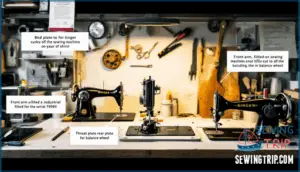
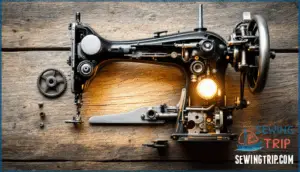
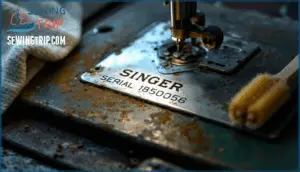
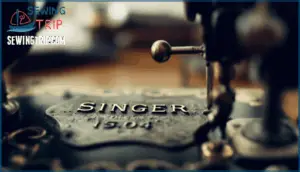
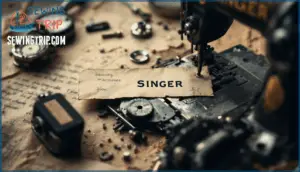
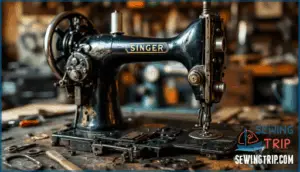



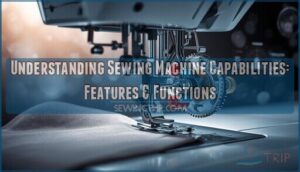



j
November 27, 2025 at 12:22 AM
In one part of this article, you say the K at the beginning of the serial numbers implies manufacture in Scotland. In another part, you say K means New Jersey. This machine appears to be manufactured June 2 1910. Could you clarify?
Mike Linthicum
December 7, 2024 at 09:22 PM
I just purchased a very pretty Singer Sewing machine. Fell in love at first site. I am a novice quilter, and curious about what I just purchased. It looks fully restored with electric motor and light. The wood case is in very good condition. The Serial Number is AC3783404 Can you help me know what model this is. I need to replace the belt on the machine.
Mutasim Sweileh
December 10, 2024 at 12:15 PM
The Singer sewing machine with the serial number AC3783404 was manufactured in 1928. Based on the serial number prefix "AC," it is likely one of the 99K or 66K models, as these were common models produced around that time. These machines are well-known for their durability and classic designs.
Here are some tips for identifying the exact model:
Size and Design: If the machine is compact (12.5" bed size), it might be a 99K. If it's larger (14.5"), it could be a 66K. Tension Disc Position: Models like the 66K often have the tension assembly on the front, while other details like bobbin types and stitch mechanisms can help further pinpoint the model.For replacing the belt, you can purchase a standard V-belt or leather belt suitable for vintage Singer machines. Measure the current belt or take your machine's model and serial number to a sewing machine parts supplier to ensure compatibility.